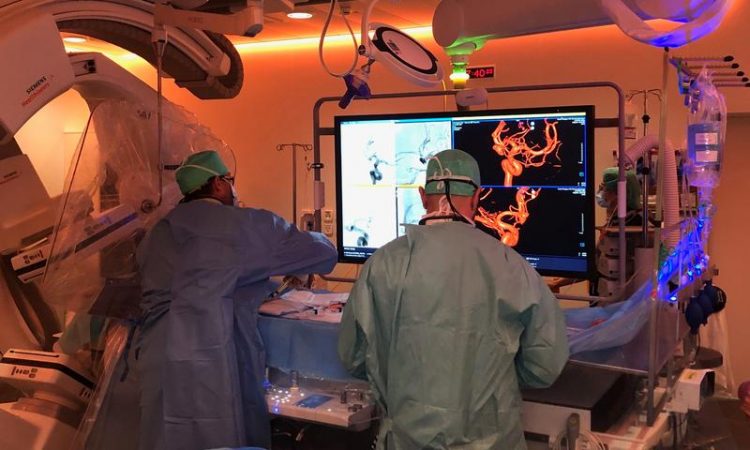Stroke therapy – study shows positive effects of Urokinase

Mechanische Thrombektomie nach Stroke J. Gralla, University Hospital Berne
Since 2015, the mechanical removal of the blood clot (endovascular mechanical thrombectomy) has been the standard procedure for treating patients with an occluded cerebral artery (stroke).
Several randomized studies have shown that there is a relevant reduction in the degree of disability among stroke patients with this therapy.
Endovascular mechanical thrombectomy has been routinely performed at Inselspital since 2010. Between 300-400 patients are treated at Neurozentrum every year. Currently, the scientific focus in the area of endovascular stroke therapy lies primarily on expanding the area of use for the procedure, organizing stroke networks as well as improving the restoration of blood flow (reperfusion).
Objective: To improve the patency of blood vessels
In a meta-analysis published in 2018 (doi: 10.1136/jnnp-2017-317602), the research team led by Dr. Kaesmacher, Prof. Gralla and Prof. Fischer was able to show that there was a statistically significant and relevant difference for the patient as to whether the brain tissue is completely (so-called TICI3 result) or almost completely refused (so-called TICI2b result)1 with mechanical thrombectomy.
Therefore, intensive research is being conducted into ways of further improving reperfusion when no further mechanical improvements can be achieved. Apart from invasive rescue treatments such as inserting a permanent stent into a cerebrovascular vessel, a recently published study in Bern showed that the administration of coagulation-dissolving medicines (thrombolytics) through the catheter could improve the reperfusion result and thus reduce the degree of disability, without increasing the risk of bleeding.
Dr. Kaesmacher reports: “Until now, the significance of administering intra-arterial thrombolytic medicines following mechanical thrombectomy has not been clarified.
Accordingly, the recommendation of the American Stroke Association regarding its use has been cautious. The published results of the study thus constitute an important component in defining the future significance of the intra-arterial administration of fibrinolytics.”
Intra-arterial dissolution of blood clots has potential for improvement
The patients analyzed in the study (doi: 10/1001/jamaneurol.2019.4192) published in JAMA Neurology showed residual peripheral occlusions subsequent to mechanical thrombectomy, which led to an almost complete rather than a complete reperfusion.
The authors of the study were able to show that these peripheral occlusions could often be dissolved with the intra-arterial administration of a special thrombolytic (Urokinase) and thereby further improve reperfusion.
This was also reflected in a better outcome among the patients. In particular, it is important to note that the study found no increased risk of bleeding following the additional intra-arterial administration of Urokinase. The risk of symptomatic bleeding after the intra-arterial administration of Urokinase was 5.2% and 6.9% in the control group.
“Further studies are still needed for a widespread use of this procedure, and a pan-European, multicenter study is already well under way,” explains Prof. Dr. Jan Gralla, the neuroradiological senior author of the study. Co-supervisor of the study, Prof. Dr. Urs Fischer, summarizes: “The chosen approach constitutes a promising therapeutic strategy with which the therapeutic benefit of endovascular stroke treatment can be further improved. For patients with a low risk of bleeding, this means it is now more important than ever to do everything possible to further improve the reperfusion result.”
Wissenschaftliche Ansprechpartner:
– Prof. Dr. med. Jan Gralla
– Prof. Dr. med. Urs Fischer
– Dr. med. J. Kaesmacher
Kaesmacher J, Bellwald S, Dobrocky T. 2019: Safety and Efficacy of Intra-arterial Urokinase After Failed, Unsuccessful or incomplete Mechanical Thrombectomy in Anterior Circulation Large-Vessel Occlusion Stroke; doi: 10/1001/jamaneurol.2019.4192
Media Contact
More Information:
http://www.insel.chAll latest news from the category: Medical Engineering
The development of medical equipment, products and technical procedures is characterized by high research and development costs in a variety of fields related to the study of human medicine.
innovations-report provides informative and stimulating reports and articles on topics ranging from imaging processes, cell and tissue techniques, optical techniques, implants, orthopedic aids, clinical and medical office equipment, dialysis systems and x-ray/radiation monitoring devices to endoscopy, ultrasound, surgical techniques, and dental materials.
Newest articles

Bringing bio-inspired robots to life
Nebraska researcher Eric Markvicka gets NSF CAREER Award to pursue manufacture of novel materials for soft robotics and stretchable electronics. Engineers are increasingly eager to develop robots that mimic the…

Bella moths use poison to attract mates
Scientists are closer to finding out how. Pyrrolizidine alkaloids are as bitter and toxic as they are hard to pronounce. They’re produced by several different types of plants and are…

AI tool creates ‘synthetic’ images of cells
…for enhanced microscopy analysis. Observing individual cells through microscopes can reveal a range of important cell biological phenomena that frequently play a role in human diseases, but the process of…





















